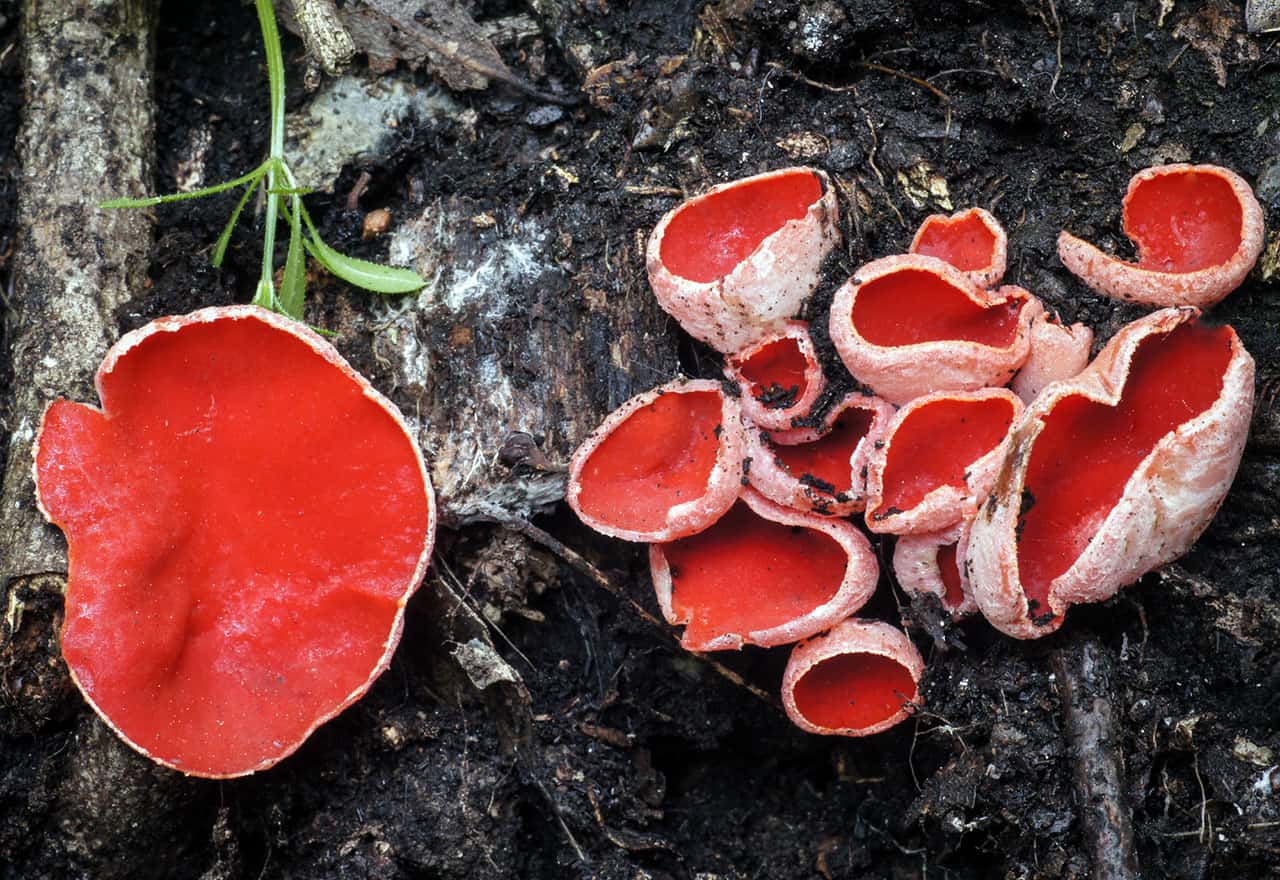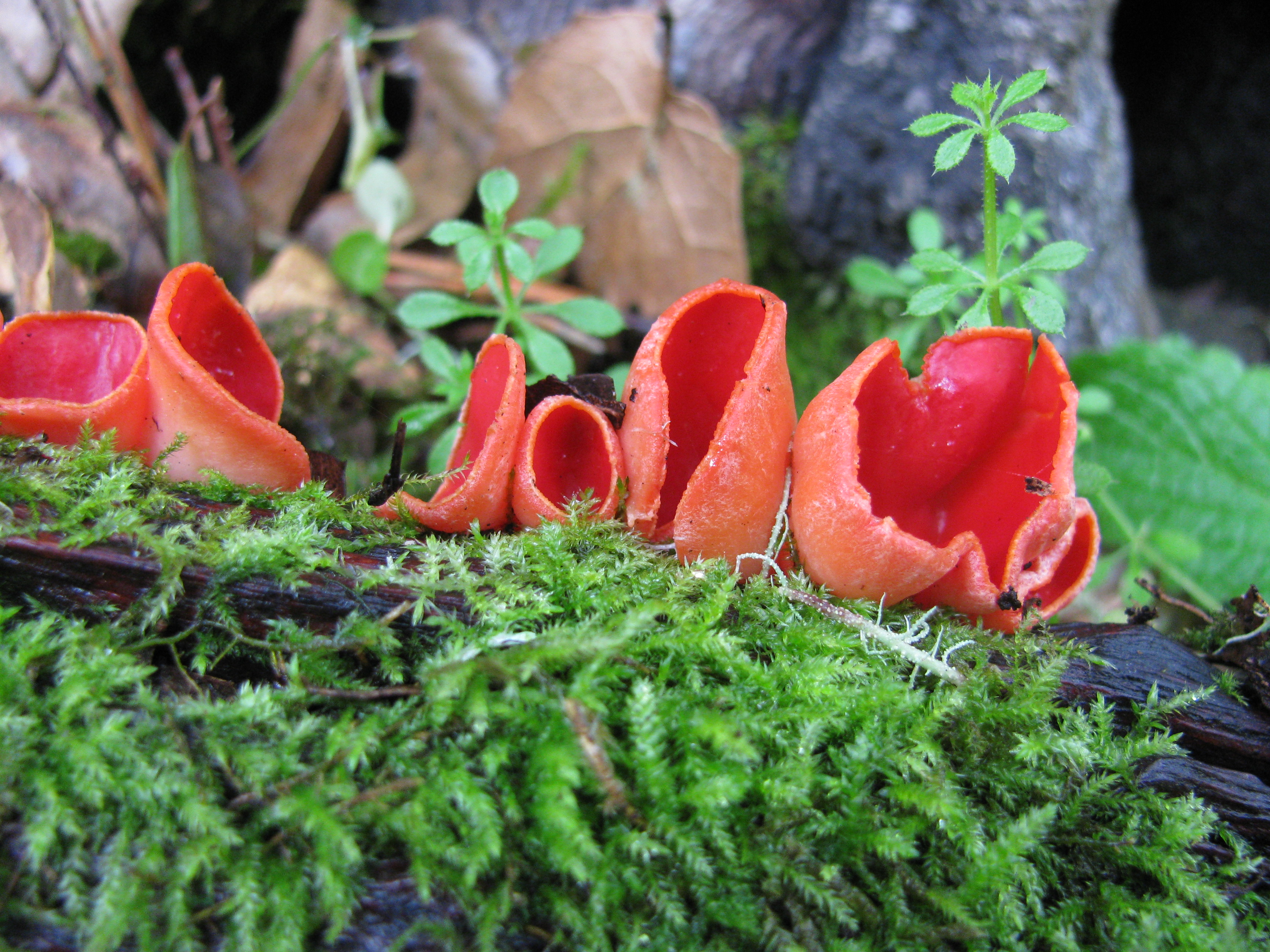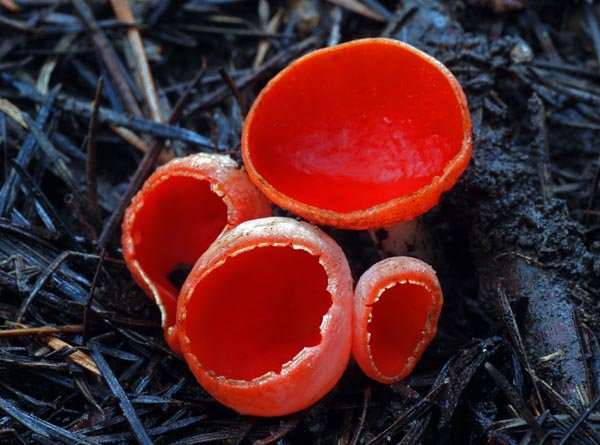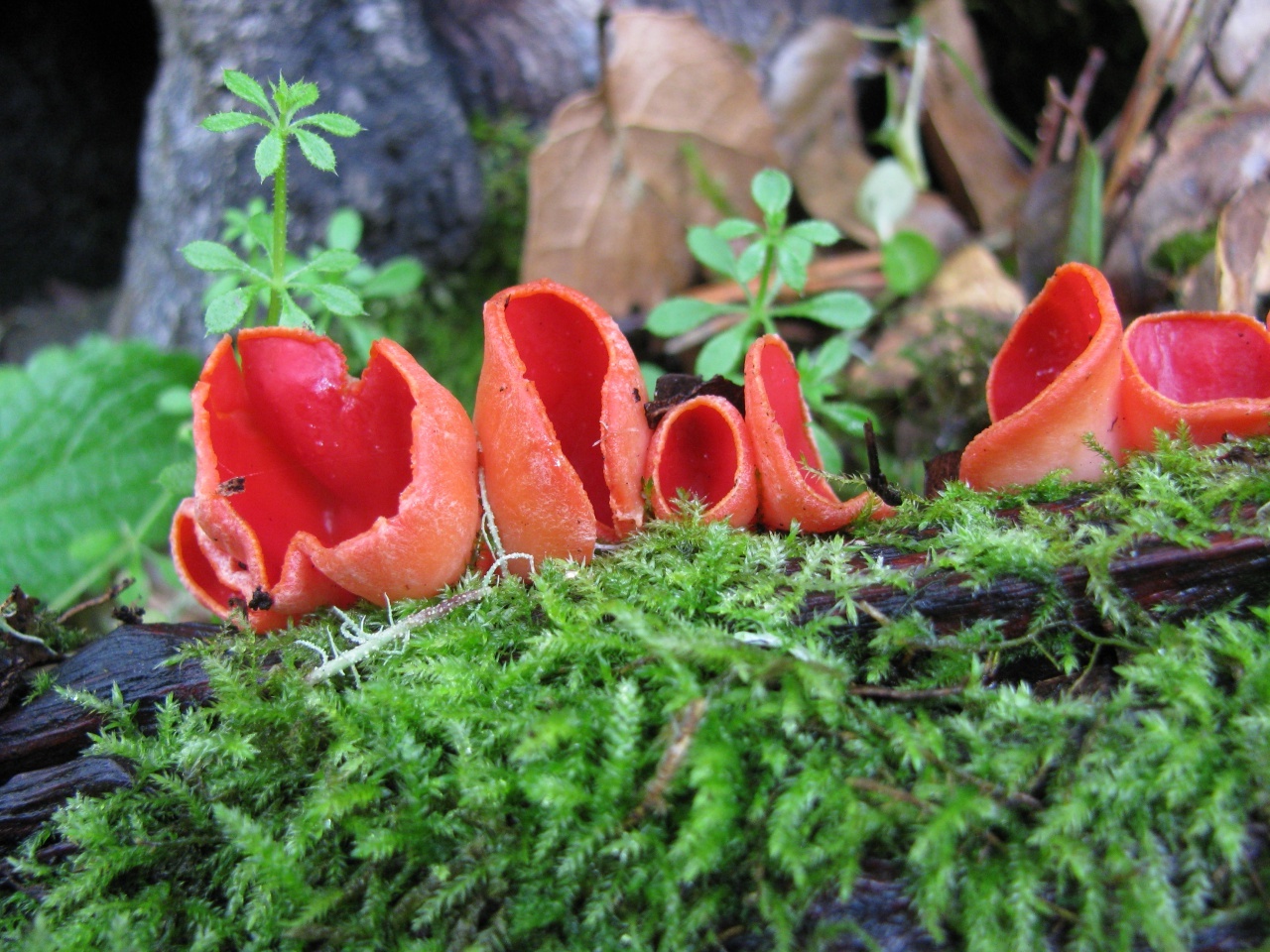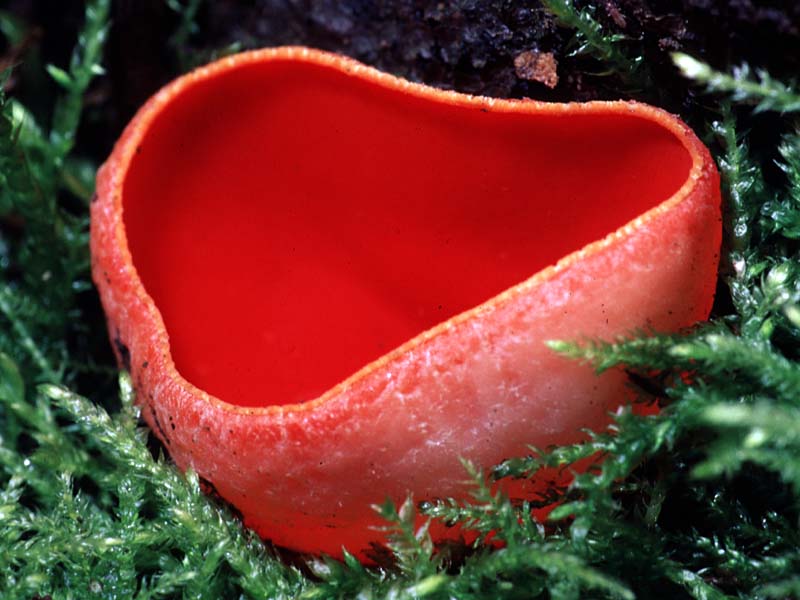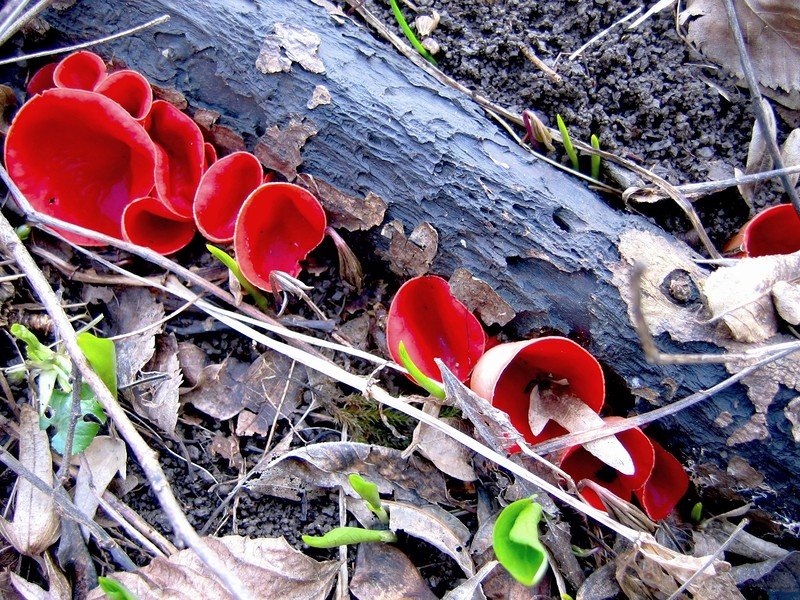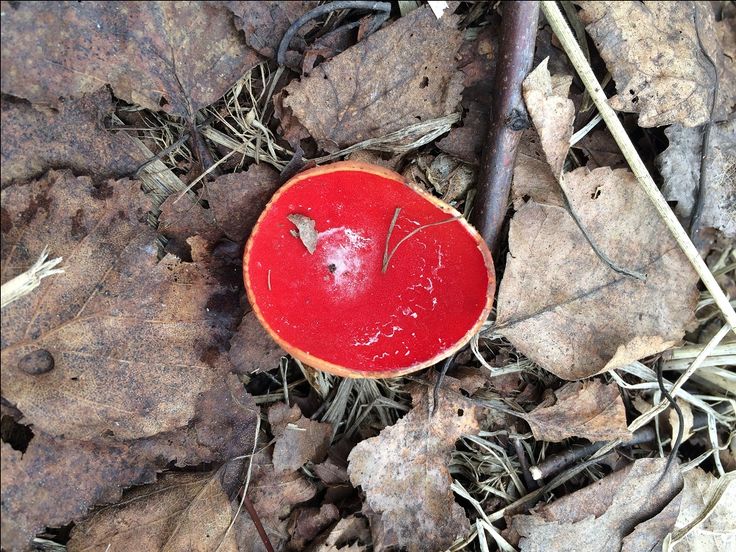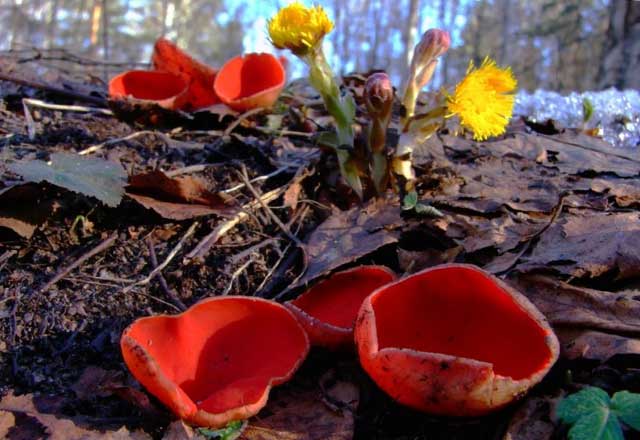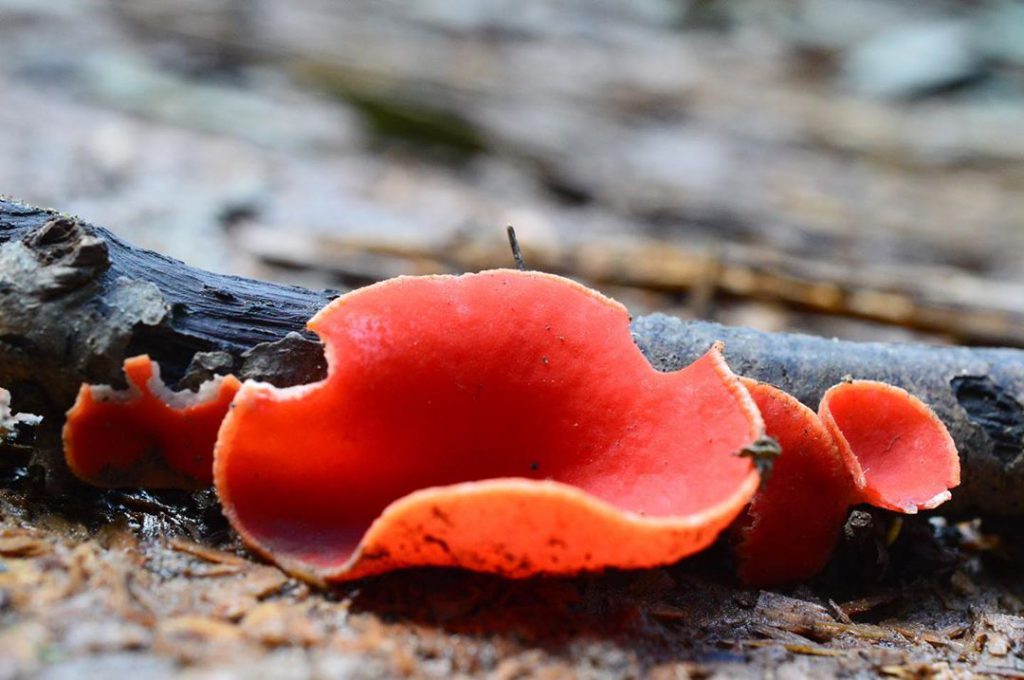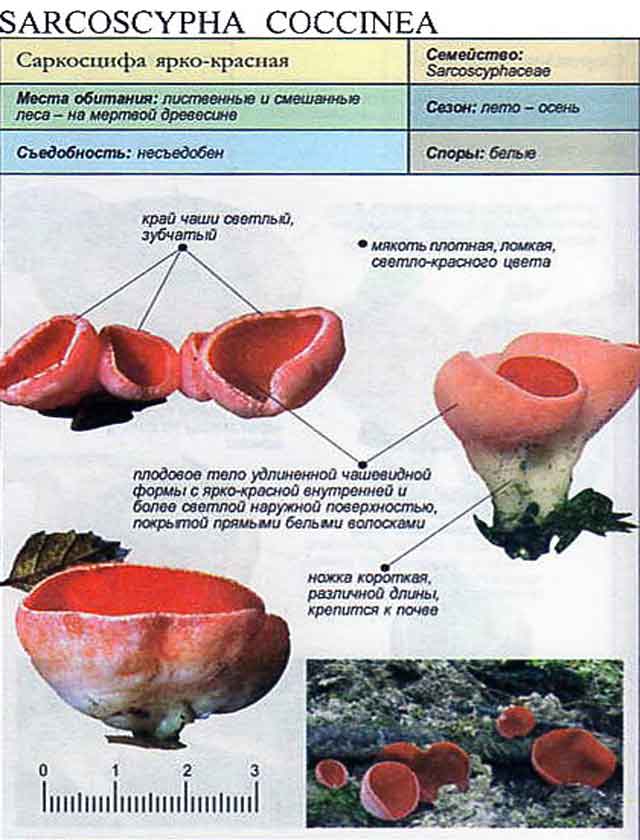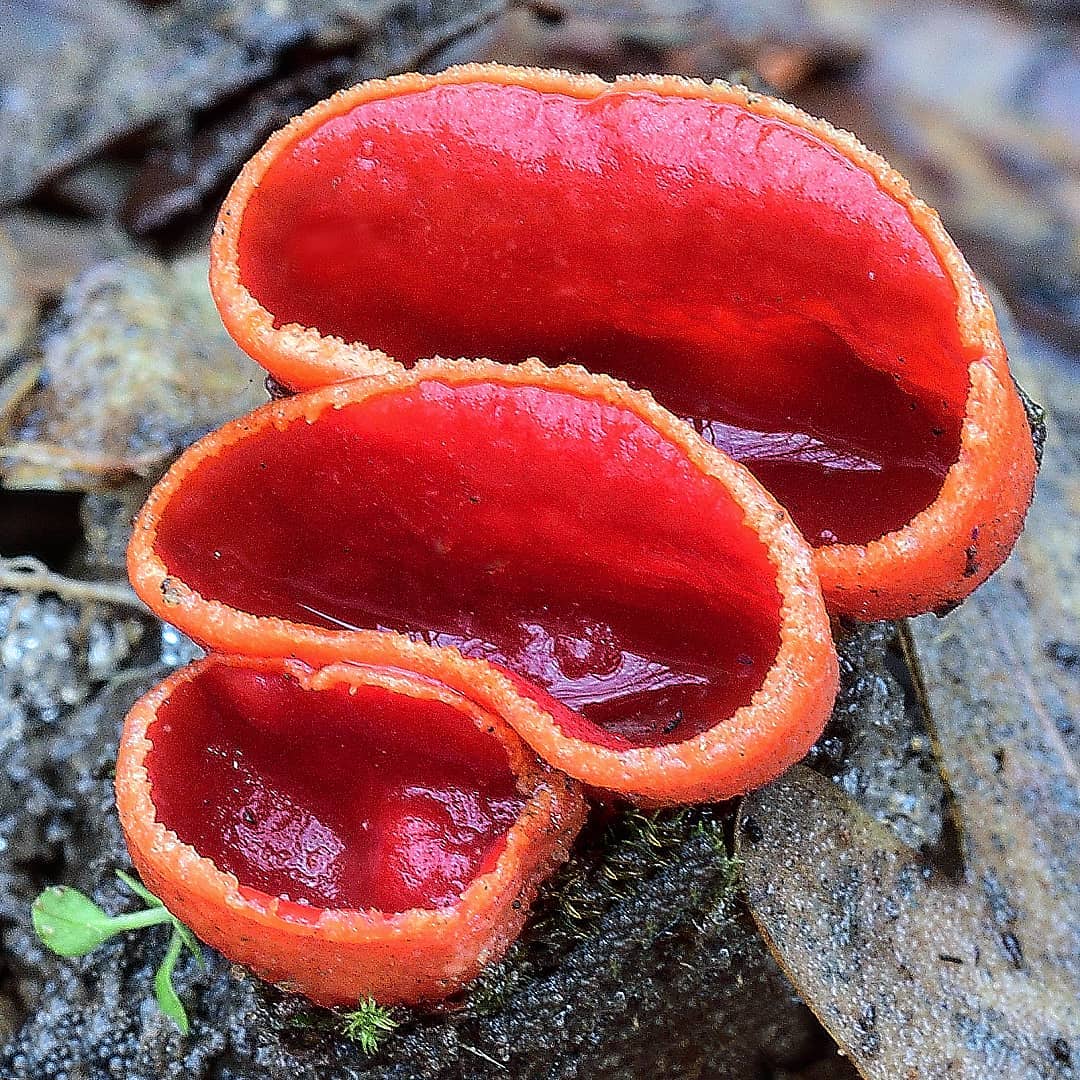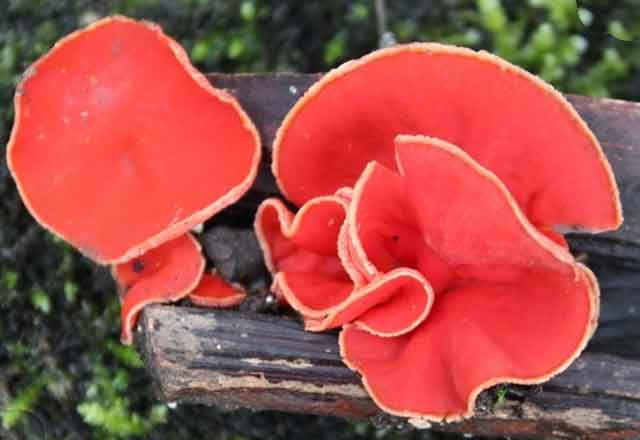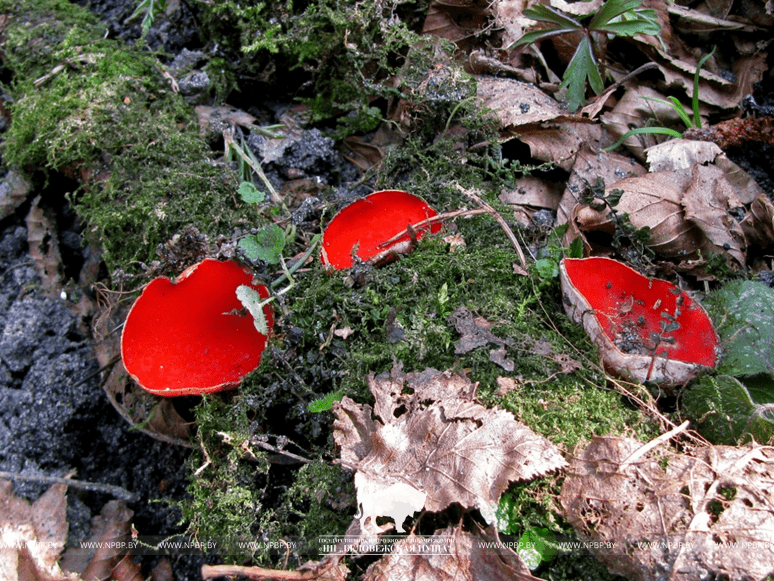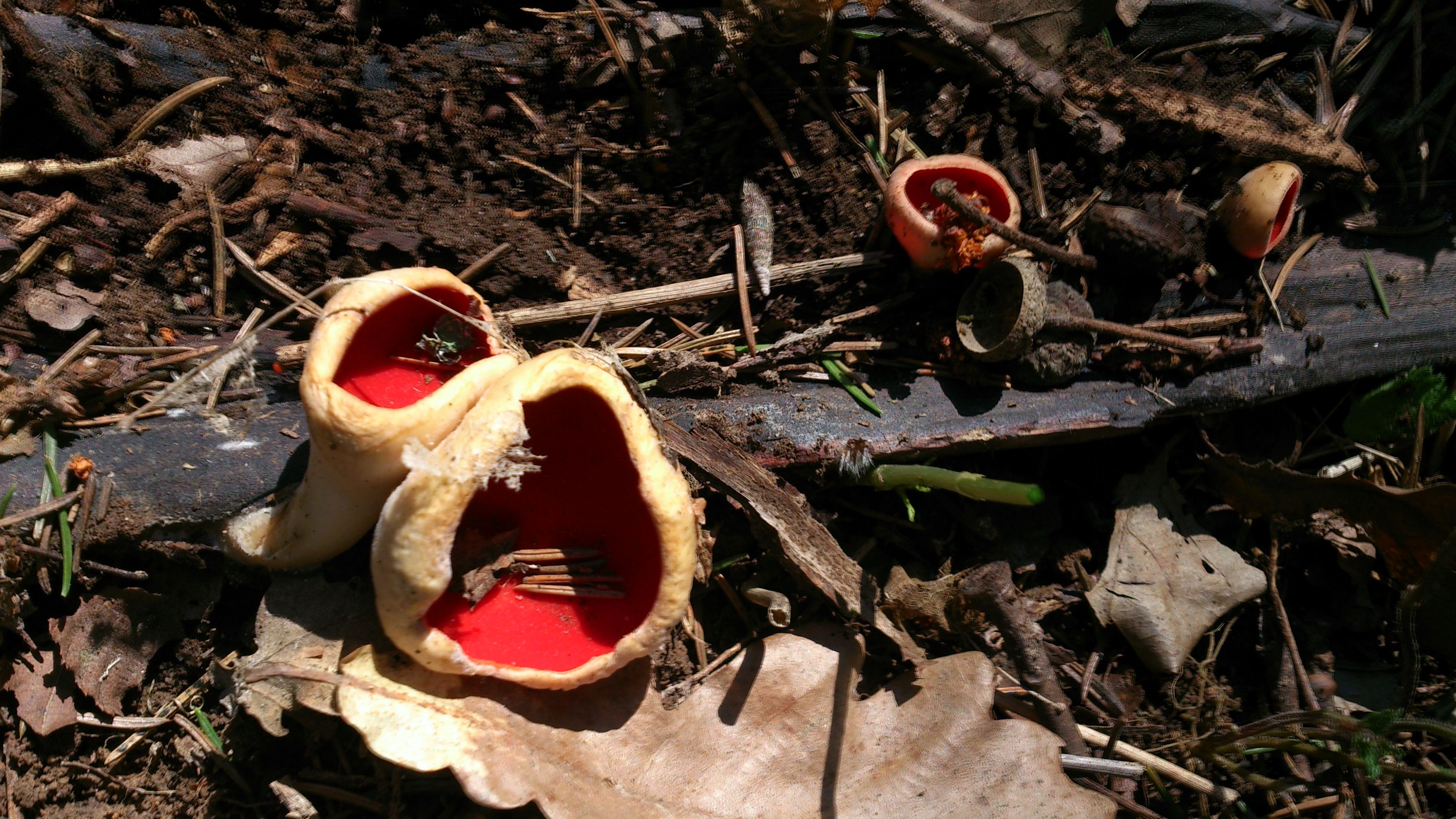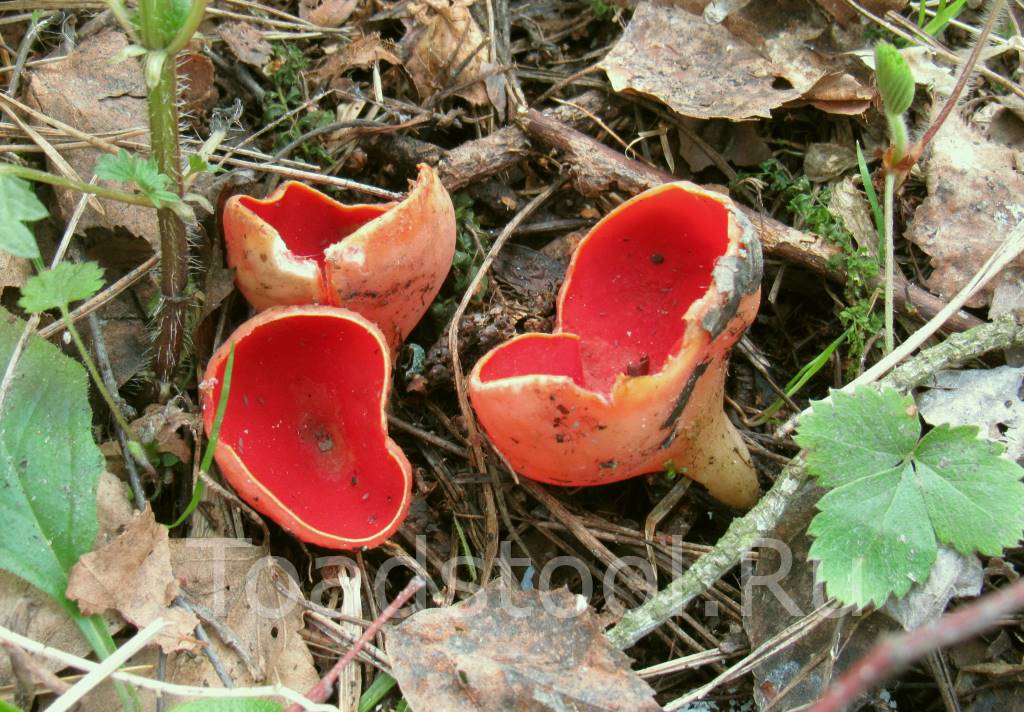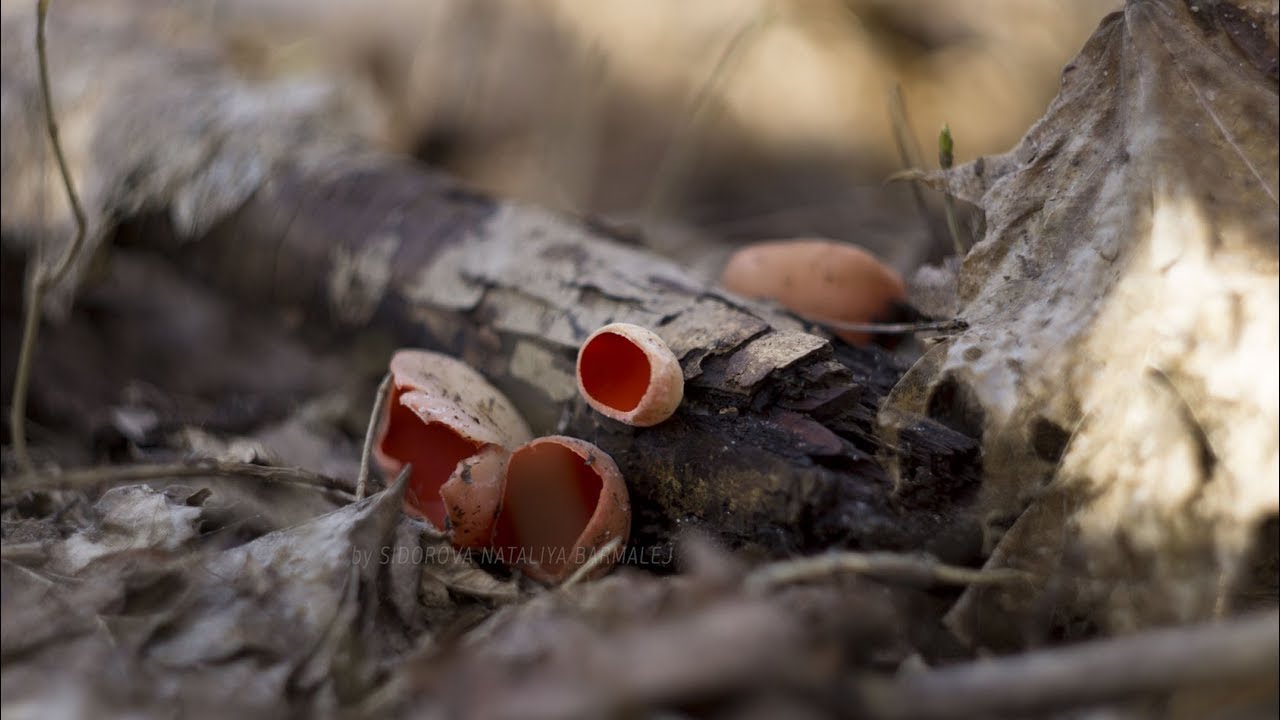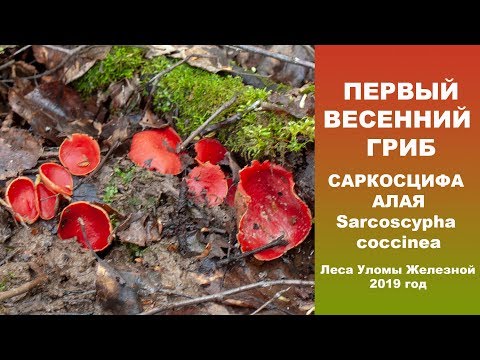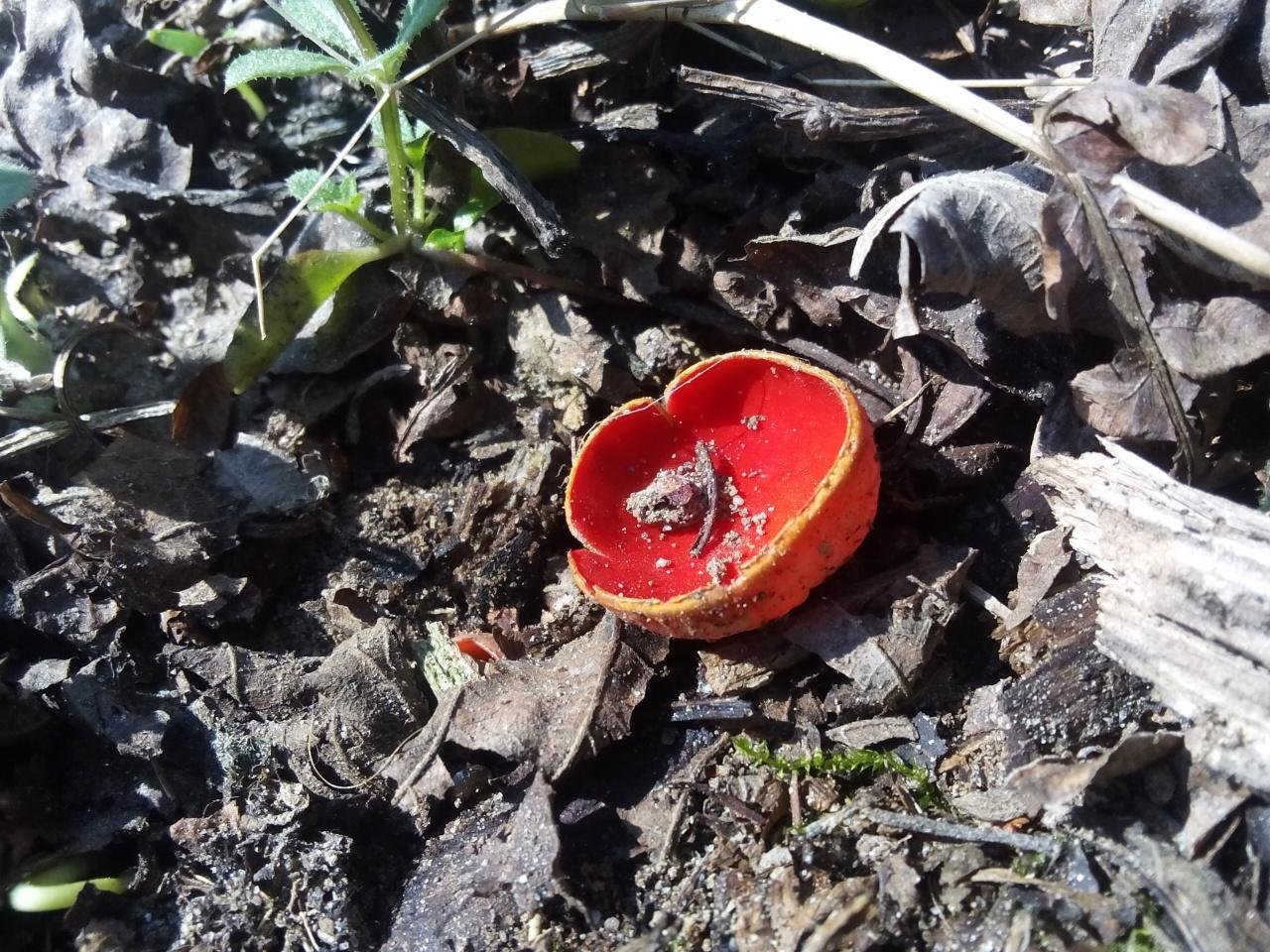Sarcoscif alai
| Group: | Marsupials |
| Plates: | Absent |
| Colour: | Scarlet, pinkish white |
| Info: | Shaped like a thicket |
| Department: | Ascomycota (Ascomycetes) |
| Subdivision: | Pezizomycotina (Pesizomycotins) |
| Class: | Pezizomycetes (Pecicomycetes) |
| Subclass: | Pezizomycetidae (Pecicomycetes) |
| Order: | Pezizales |
| Family: | Sarcoscyphaceae |
| Genus: | Sarcoscypha |
| View: | Sarcoscypha coccinea (Sarcoscif scarlet) |
There are mushrooms whose value lies not at all in their edibility or medicinal qualities. Their value is purely aesthetic. And these mushrooms are exactly the sarcoscifa scarlet. She argues for the title of the first spring mushroom with morels and stitches, and its picturesque fruiting bodies become the first truly bright spots among the white-gray range of the early spring forest.
Fruiting body
Ascocarp (the so-called fruit body of the scarlet sarcoscifa) is a dense bowl of rather modest sizes (from 1 to 5 centimeters), outside it has a white or pinkish-white color, and inside it is painted in a bright, catchy cinnabar-scarlet color.
The bowl is located on a short, about 3 centimeters leg, colored in the same way as the outside of the bowl of the mushroom. The leg reaches 6 centimeters in thickness.
To the touch, the surface of the mushroom is delicate, velvety, the pulp at the break is pink-red, mushroom aroma and neutral taste. The spores of the scarlet sarcoscifa ripen on the inner surface of the bowl, are elliptical in shape and pink-red in color.
Distribution and collection
Sarkoscifa scarlet is an absolutely cosmopolitan mushroom and is found on all continents except Antarctica. In our latitudes, the scarlet sarcoscith is found both in coniferous and deciduous, and mixed forests. This mushroom settles on dead, rotting wood, preferring deciduous species - beech, oak, maple and willow. Grows in groups, often numerous.
Similar species
Sarkoscifa western
It grows on a longer stem, colored lighter than that of the scarlet sarcoscif. It is not found in our latitudes, its homeland is Central America and the USA.
Use
Now, many sources on the Internet indicate that scarlet sarcoscifa is an edible mushroom and it is recommended to boil it for 15 minutes before eating. Those who have tried it note that this mushroom is tasty, but it has a rather tough, cartilaginous pulp.
However, the authors of such recommendations completely ignore the need for long-term studies of the consequences of the use of this type of mushroom. It is known that many mushrooms contain small amounts of substances that, when consumed regularly, have a cumulative effect, the effect of accumulating a critical mass.
It is not known whether sarcoscifa scarlet contains such substances, therefore it is not recommended to eat this mushroom regularly.
Interesting Facts
Sarkoscifa is an excellent ecological biomonitor that demonstrates the ecological state of the forest. It never grows in polluted areas, near industrial zones and roads. If you saw the scarlet sarcoscifa in the forest, you can be sure that this part of the forest is ecologically safe.
Sarcoscifa cinnabar red
Mushroom pickers of all countries - unite! (WITH) Mushroom pickers on Facebook
Sarcoscypha coccinea
This mushroom appears in the spring, immediately after the snow melts in the forest. It grows on branches of deciduous trees submerged in the ground. It is difficult to say whether it is worth eating it ... But the fact that the mushroom is an adornment of the spring forest is unambiguous!
Sarcoscifa cinnabar red
Synonyms: sarcoscifa bright red, scarlet bowl
Description of the mushroom Sarkoscifa cinnabar red
The fruit body of the fungus Sarkoscif is cinnabar-red, 1-5 cm in diameter, cupped, often almost open to maturity, with a wavy-sinuous, often cracked edge.The outer surface is whitish or pinkish, sometimes buffy, densely covered with whitish hairs, tomentose. The inner surface is smooth, covered with a bright red or deep pink hymenial layer.
The leg of the Sarkoscif fungus is cinnabar-red deeply immersed in the substrate, very short, narrowed at the base, hairy, lighter than the "bowl".
The pulp of the Sarkoscif fungus is cinnabar-red, thin, fragile, waxy, reddish, without any special smell or taste.
Asci of the Sarkoscif fungus are cinnabar-red cylindrical, 400-500 x 15-18 microns, 8-spore.
Sarkoscifa cinnabar-red in Ukraine grows in groups on deadwood branches of deciduous trees (including those submerged in the soil) in deciduous forests in April-May. In the mountainous part of Crimea, fruit bodies are formed mainly in December-March. It is not common.
The mushroom is inedible. But also not poisonous. In some literature, this species is classified as conditionally edible of low quality. It is not of particular value from the point of view of nutrition.
Similar species: In the shape of the fruit body, this species is similar to the species of the genus Peziza, from which it differs in the bright red color of the inner surface of the "bowl".
Interesting information about the cinnabar-red Sarcoscife
There is evidence that some Indian tribes prepare powder from dried fruit bodies and use it as a hemostatic agent.
Photos to the description of Cinnabar-red Sarcoscifa
Sarcoscifa cinnabar red Sarcoscifa cinnabar red Sarcoscifa cinnabar red Sarcoscifa cinnabar red Sarcoscifa cinnabar red
When and where they found cinnabar sarcoscifa
This page is a description of the mushroom Sarkoscifa cinnabar red according to the mushroom guide. Photos taken for the illustrated mushroom atlas.
Join our new group
lovers of quiet hunting
Description of the mushroom sarcoscif
The sarcoscith mushroom appears in springtime. It is small and bright red in color, making it easy to confuse with berries or last year's leaves.
Description of the mushroom sarcoscif
Description of the mushroom
Sarcoscifa has a bright red color, a small shape and a pleasant smell. It is edible, but is more often used as a decoration for the table.
The cap of the mushroom has a round shape, the diameter is up to 5 cm. Its bottom is white, which distinguishes the variety from poisonous species. The pulp has dark veins.
The leg is 1.5-2 cm, white, but it is practically invisible.
The smell of sarkosciph is pleasant, but during cooking it practically disappears.
The color and shape of the mushroom resembles a poisonous product. But this plant is safe for health if cooked according to all the rules.
Sarkoscif has no species. Its color can change depending on the climate. With high humidity, the mushroom takes on a bright red color. At low temperatures, it is paler.
Beneficial features
Sarcoscifa is used for colds and diseases of the respiratory system. Her vapors remove phlegm from the lungs and relieve a cold.
The mushroom is enriched with vitamins and fiber, which have a positive effect on the human body, and also fight against gastrointestinal problems.
Sarcoscifa is often used during weight loss: it removes toxins and toxins, and also contains a small amount of calories (30-35 kcal).
Contraindications
The mushroom has a number of contraindications:
- high blood pressure;
- varicose veins;
- diseases of the gastrointestinal tract.
The use of these mushrooms is prohibited for children under 12 years old and the elderly, since their bodies do not have enzymes to digest this type of mushroom.
The use of the Sarkoscif mushroom is undesirable in the presence of pregnancy: its effect on the woman's body has not been fully understood.
Application
Improper cooking of mushrooms can lead to poisoning
Sarcoscifa is used both for food and for the manufacture of medicines.
In medicine
Sarcoscifa is used for poisoning and if a natural antiseptic becomes necessary. Self-medication is strictly prohibited, because.the mushroom has a list of contraindications. There are also age restrictions for consumption.
In cooking
When preparing dishes with these mushrooms in the composition, you should be careful: incorrect proportions can lead to poisoning.
More often the mushroom is used for decoration and table setting.
In cooking, the head of the product is often used: the leg collects all toxins and dirt. It is used only for pickling after a long digestion: it provides additional juice.
Growing methods
Only a competent mushroom picker will be able to grow a plant on their own: you need to know its features and climatic needs.
Deciduous trees are necessary for growth: their fallen leaves are fertilizer for fungi. It also requires a lot of light and moisture: these are the 2 main aspects for the growth and achievement of the fleshiness of the mushroom pulp.
general description
This mushroom has many other names. It is called the scarlet cup, the scarlet elven cup. There are other names as well. In Latin, the name of the mushroom sounds like Sarcoscypha Coccinei. This representative belongs to the marsupial mushrooms, has a small size. The appearance of this fungus is late winter or early spring. But by the end of May, the fruiting process ends. Before it was described by scientific minds, it was already familiar to many fans of mushroom hunting, it was collected and even eaten. Moreover, it has long been known that this mushroom has some medicinal properties.
Sarcoscifa belongs to the early mushrooms, which begin to be collected at the end of winter. The diameter of the cap ranges from 1 to 5 cm. The height can reach 2 cm. When viewed externally, the mushroom can be compared to a bowl or glass. The hat has edges that are rolled inward. The mushroom is distinguished by its bright red color and white edges. If you feel the hat, you can find some wooliness.
As for the stem of the mushroom, it never grows more than 3 cm. The leg thickness ranges from 4 to 6 mm. In the direction from the cap downwards, a distinct narrowing can be observed. The leg is sometimes very difficult to see, because it is always covered with a layer of earth.
The mushroom pulp is devoid of any elasticity and has a rather pronounced dense character. The mushroom has a weak taste and aroma. Despite this, it exudes a rather pleasant mushroom smell. Its taste is also highly controversial. But, as they say, how many people, so many opinions. When eaten, it can be noted that the mushroom is crispy, with a pronounced inherent density. It is characteristic that even after significant heat treatment, the scarlet color of the mushroom does not disappear anywhere, but retains its original appearance.
Description
The mushroom belongs to the genus Sarkoscif, the family of the same name and is a species of marsupials. Despite its rarity and uniqueness, this species is not included in the Red Book. It is widespread throughout the world: in Asia, Afik, Europe, America, Australia.
Sarcoscifa has a number of other names. Latin Sarcoscypha coccinea and Sarcoscypha austriaca, it is also often called the bright red Sarcoscifa or cinnabar red. There is the name of the Austrian Sarcoscif, Red Pecitsa and the Scarlet Elf Bowl.
If we describe the appearance of the mushroom, then it is a saprophyte that grows on the trunks or branches of trees, it has a rather small size, elastic flesh, a low peduncle. But the main feature is the cap, which is the fruiting body. It looks like a bright red saucer, measuring 1.5 to 5 centimeters in diameter. The edges of the cap are wrapped inward and have a pale pink or white color.
The hymenophore is a part of the fruiting body of the fungus, bearing a thin spore-bearing layer on the surface. In sarcoscifes, it has a pale pink or white color and a frequent structure without division into stripes. The pulp is firm, with a pleasant mushroom aroma.
A bit of history
It is a type species of the genus Sarkoscif. Scientists from Europe (presumably Austria) described it in 1772, although it has been known for a long time.For the first time, the mushroom was used for food long before the official opening. Ancient hunters and gatherers knew him.
Sarkoscif mushroom: photo and description
Sarcoscypha is one of those mushrooms that have a very attractive appearance. With a rich imagination, they can even be compared with scarlet flowers, especially if these original fruiting bodies do not grow on dry wood, but on juicy green moss. In this case, it seems as if a dense bright bud is surrounded by bright green leaves.
The first beautiful mushrooms after the snow melts are the spring mushrooms of the sarkoscyphus, which are bright red, resembling small red cups. Although these mushrooms are small, they are surprisingly bright, which evokes a feeling of joy. Their appearance tells everyone: finally, the real spring has come! These mushrooms can be found everywhere: near roads, paths, on the edges, in the depths of the forest. They can grow on thawed patches near snowy areas.
Types of spring sarcosciths
There are two types of sarcosciths: bright red and Austrian. Outwardly, they differ little, only close and under a magnifying glass you can see small hairs on the outer surface of the bright red sarcoscife, which are not present in the Austrian sarcoscife. For a long time, the literature wrote that the edibility of these mushrooms is unknown or that they are inedible.
All mushroom pickers are interested in: are sarcoscifs edible or not? Now there is a lot of information on the Internet about the edibility of these mushrooms, even in its raw form. I would like to note that a one-time use of mushrooms, after which nothing happened, is not yet a reason for their constant use. For mushrooms, there is such a concept as the possible accumulation of harmful substances from repeated use. It is because of this property, for example, that thin pigs were officially classified as inedible and even poisonous twenty years ago. Since scientists have not yet said their final word about sarcosciths, they cannot be classified as edible. In any case, they must be boiled for at least 15 minutes.
This means that they grow in ecologically clean areas. The authors of the book annually observe these mushrooms in the Istra district of the Moscow region. It should be noted that these mushrooms began to adapt to changes in external conditions and are now very common.
If sarcoscifs are massive mushrooms, then there are other rare similar mushrooms in the form of yellow cups. They grow once every two to three years. They were last seen in 2013. They are called Caloscyphe fulgens.
Take a look at the photo of what different types of sarcoscifs look like:
Sarkoscif mushroom bright red
Where bright red sarcoscyphs grow (Sarcoscypha coccinea): on fallen trees, branches, on litter in moss, more often on deciduous trees, less often on spruces, grow in groups Season: the very first mushrooms that appear along with the melting of snow in spring, April - May, less often until June.
The fruit body of a bright red sarcoscifa has a diameter of 1-6 cm, a height of 1-4 cm. A distinctive feature of the species is a goblet shape with a cup and stem of bright red color inside and whitish outside with short white hairs. The form straightens over time and the edges become light and uneven.
The leg is 0.5-3 cm high, conical, 3-12 mm in diameter.
The flesh of the sarcoscith mushroom is bright red, dense, scarlet. Young specimens have a faint pleasant odor, while mature specimens have a “chemistry” like DDT.
Variability. The color of the fruiting body inside the cup changes from bright red to orange.
Similar species. According to the description of the sarcoscifa, bright red is surprisingly similar to the Austrian sarcoscypha (Sarcoscypha austriaca), which has similar properties, but does not have small hairs on the surface.
Edible: There is a lot of information on the Internet that sarkoscif is edible. However, the properties of the long-term effects of these mushrooms on the body have not been studied, therefore, from a scientific point of view, they are officially inedible.
Primary processing and cooking recipes
When preparing, the mushrooms must be cleaned of moss and dirt, but do not rush to immediately lower them under running water. It is better to soak the fruits in a bowl or saucepan, and then gently clean up the adhering dirt. Then cut the leg, separate the hats and lay them on a piece of cloth or gauze on the windowsill. When the mushrooms are dry, you can collect them in a container and put them in the freezer. Or soak it in order to cook some kind of dish out of them.
Extinguishing
sarcoscife - up to 1 kg; Onions - 1 pc.; Salt - 2 tablespoons; Olive oil - 2 tablespoons; Carrots - 1 pc.; Tomatoes - 3 pcs.
- It is best to stew sarcoscifa in a finely chopped form, in a slow cooker.
- For this, the mushrooms are salted, a little olive oil, chopped carrots, onions, tomatoes are added.
- It is necessary to simmer in a special mode for about 60 minutes.
- The mushrooms can then be served along with soy sauce and rice. The result is an exquisite treat reminiscent of Japanese cuisine.
Frying
Sarcoscifa - up to 1 kg; Onions - 1 pc.;
Garlic - 1 pc.; Salt - 2 tablespoons; Olive oil - 2 tablespoons; Frozen vegetables - 200 gr .; Tomatoes - 3 pcs.
- First, prepare olive oil, half a glass of water, finely chopped onions and garlic.
- Mushrooms are added already when the vegetables are slightly stewed.
- Then sprinkle with a little salt.
- Stir them every seven minutes and finish frying after 20-30 minutes.
- Serve with adjika or red sauce with rice dishes or stewed vegetables. It is also very tasty when combined with Korean carrots and sour cream.
Pickling
This option for harvesting mushrooms is the most common. You will need: sarcoscife - up to 1 kg; Garlic - 1 pc.; Salt - 2 tablespoons; Table vinegar .; Sugar - 1 tbsp. l .; Bay leaf - 2-3 pcs.; Pepper, cloves - 5 pieces each
- Chop the mushrooms, put in a saucepan with cold water and boil for up to 30 minutes.
- Then drain the water with brine into another saucepan, and put the fruits in the marinade and mix.
- Then they can be marinated and put in the refrigerator. Stir again after 24 hours and store in a cool place.
How to prepare the pickle:
- Put sugar, pepper, cloves, bay leaves, garlic in a saucepan.
- Pour all this with water, after boiling, cook for another 10 minutes and add vinegar and vegetable oil.
- Remove from heat after 10 minutes.
Description of the mushroom
Sarcoscifa has a bright red color, small size and a pleasant smell. It is edible, but is more often used as a decoration for the table. However, not everyone agrees with this statement.
The fruit body of the fungus is round, up to 5 cm in diameter. Its outer part is light in color. The pulp has dark veins.
The leg is 1.5-2 cm, light, but practically invisible.
The smell of sarkosciph is pleasant, but during cooking it practically disappears.
The color and shape of the mushroom resembles a poisonous product. But this plant is safe for health if cooked according to all the rules.
The genus of Sarkoscif includes the following species:
- with. bright scarlet;
- with. Austrian;
- with. Dudley;
- with. macaronesian;
- with. western.
On the territory of Russia there are 2 types of sarcosciths: s. bright scarlet and s. Austrian.
The color may vary depending on the climate. With high humidity, the mushroom takes on a bright red color. At low temperatures, it becomes paler in color.
Sarkoscif mushroom: photo and description

The first beautiful mushrooms after the snow melts are the spring mushrooms of the sarkoscyphus, which are bright red, resembling small red cups. Although these mushrooms are small, they are surprisingly bright, which evokes a feeling of joy. Their appearance tells everyone: finally, the real spring has come! These mushrooms can be found everywhere: near roads, paths, on the edges, in the depths of the forest. They can grow on thawed patches near snowy areas.
Types of spring sarcosciths
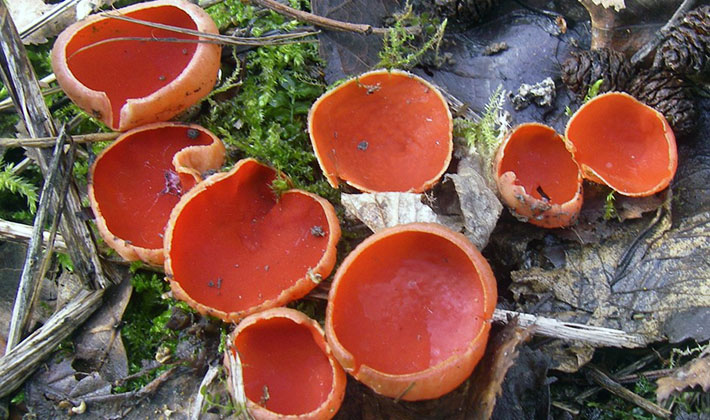
All mushroom pickers are interested in: are sarcoscifs edible or not? Now there is a lot of information on the Internet about the edibility of these mushrooms, even in its raw form.I would like to note that a one-time use of mushrooms, after which nothing happened, is not yet a reason for their constant use. For mushrooms, there is such a concept as the possible accumulation of harmful substances from repeated use. It is because of this property, for example, that thin pigs were officially classified as inedible and even poisonous twenty years ago. Since scientists have not yet said their final word about sarcosciths, they cannot be classified as edible. In any case, they must be boiled for at least 15 minutes.
This means that they grow in ecologically clean areas. The authors of the book annually observe these mushrooms in the Istra district of the Moscow region. It should be noted that these mushrooms began to adapt to changes in external conditions and are now very common.
If sarcoscifs are massive mushrooms, then there are other rare similar mushrooms in the form of yellow cups. They grow once every two to three years. They were last seen in 2013. They are called Caloscyphe fulgens.
Take a look at the photo of what different types of sarcoscifs look like:



Sarkoscif mushroom bright red
Where bright red sarcoscyphs (Sarcoscypha coccinea) grow: on fallen trees, branches, on litter in moss, more often on deciduous trees, less often on spruces, they grow in groups.

The fruit body of a bright red sarcoscifa has a diameter of 1-6 cm, a height of 1-4 cm. A distinctive feature of the species is a goblet shape with a cup and stem of bright red color inside and whitish outside with short white hairs. The form straightens over time and the edges become light and uneven.
The leg is 0.5-3 cm high, conical, 3-12 mm in diameter.
The flesh of the sarcoscith mushroom is bright red, dense, scarlet. Young specimens have a faint pleasant odor, while mature specimens have a “chemistry” like DDT.
Variability. The color of the fruiting body inside the cup changes from bright red to orange.
Similar species. According to the description of the sarcoscifa, bright red is surprisingly similar to the Austrian sarcoscypha (Sarcoscypha austriaca), which has similar properties, but does not have small hairs on the surface.
Edible: There is a lot of information on the Internet that sarkoscif is edible. However, the properties of the long-term effects of these mushrooms on the body have not been studied, therefore, from a scientific point of view, they are officially inedible.
Sarkoscif alai photo and description
Refers to the species of marsupial mushrooms. The sarcoscif family. The mushroom is widespread, it is found in some parts of Russia, and in Europe, and in Africa, and even in Asia and Australia.
This mushroom is saprophytic, grows, lives, and also decomposes on the branches of trees or on their trunks. This mushroom is covered with a layer of foliage, hiding under the ground, so it is rarely seen.
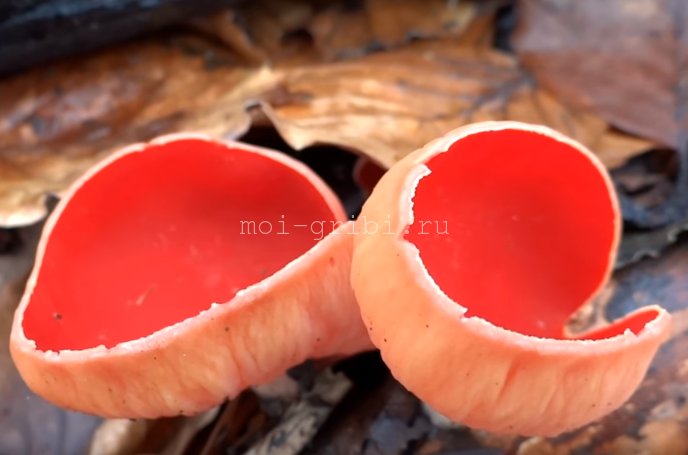
Appears in cooler months. Most often, the mushroom can be found in early spring or even in winter, back in February.
The structure is very specific. The fruit body has a maximum diameter of 5 cm. It has a goblet shape. The edges of the cap are folded upwards, thus forming a cup.
If you run your finger over the surface of the mushroom, you can feel velvety and dull. The skin itself has bright red or orange hues.
The leg is very short; rather, it can be called a rudiment. In most cases, it is deeply immersed in the substrate, which makes the mushroom appear as if sedentary.
The pulp itself is quite brittle and thin, so the mushroom needs to be touched very carefully. It smells good, has a delicious aroma. In the context of the milky period does not distinguish. Spore powder has a white tint.
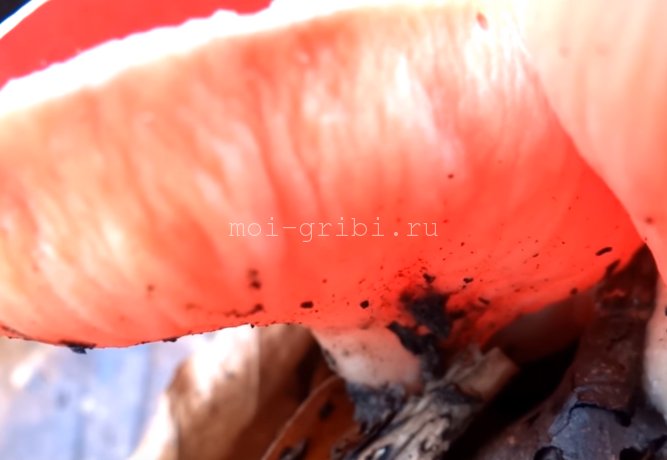
Edibility
Sarkoscifa scarlet belongs to the category of edible mushrooms. And this is very strange, because, as a rule, forest dwellers, bright in their appearance, are, on the contrary, very poisonous.
However, the mushroom does not contain harmful substances, and its use does not end with poisoning.
If you plucked sarcoscifa, which did not grow on fertile soils, near highways or industrial enterprises, you will be limited to only a slight stomach upset.
At the same time, the mushroom pulp itself is quite tough, and the appearance is not the most delicious.
Benefit
It is believed that the powder, which is extracted from the sarcoscifa scarlet in dried form, has beneficial properties. For example, it can easily stop bleeding.
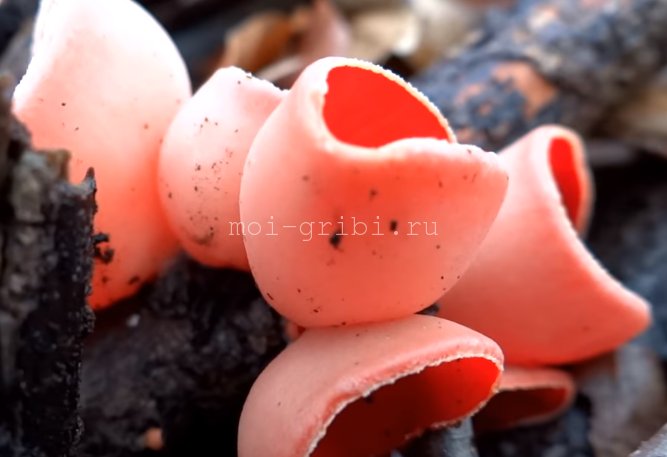
Spreading
Sarcoscifa grows in late winter or early spring. And it bears fruit from April to May.
The decisive role is played by the location of the sarkoscyphus, as well as the climate around it. Most often, it chooses dead branches, rotting wood for its growth and development. More found in deciduous forests than in coniferous or mixed forests.
However, he chooses for himself the rotten wood of the sarcoscith only in the European and Asian parts. In the USA, this mushroom prefers oak branches, and also enters mycorrhiza with this tree. Appears immediately after the snow has melted.
In contrast, in South Africa, this mushroom loves cool weather. It enters mycorrhiza with local deciduous trees, but does not prefer to settle on wood, since it quickly decays under the influence of a warm and humid climate.
False doubles
The mushroom has very similar cousins, some of which are poisonous.
| Aleuria orange | Sarkoscifa western | Caustic russula |
| edible | edible | inedible |
| spherical shape | saucer shape | saucer shape |
| color orange, reddish | the color is reddish, brighter than the original | ocher color |
| Shorter leg | The leg is longer | The leg is longer |
| Nonpoisonous | Nonpoisonous | Poisonous |
| The area is the same | Only grows in the USA | Grows in Western Europe |
IMPORTANT: the burning-caustic russula is the most dangerous species of those presented. It differs in that it has an ocher color, but the hat often looks like a sarcoscifa - it is also reddish
Moreover, the mushroom itself is hazardous to health. Even after trying it, a person experiences a strong burning sensation on the tongue. By the way, the older the mushroom, the brighter its hat. When eaten, it can cause symptoms similar to common poisoning, but in children it can provoke serious health problems.
The difference can be seen in the photo.

